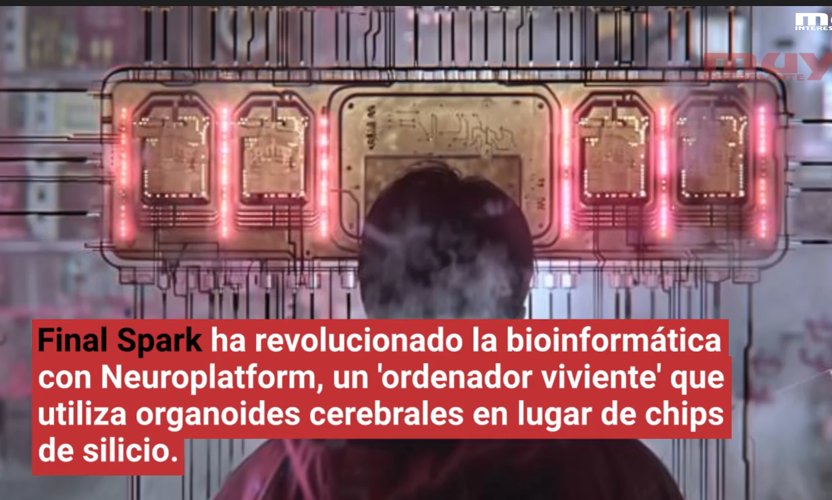The first ‘living computer’ with 16 brains grown in the laboratory

Bioprocessors have many advantages. Among them, incredible energy savings compared to traditional ones.
A Swiss technology company called Final Spark has successfully launched what they call Neuroplatform, the world’s first bioprocessing platform in which, instead of being made up of the usual silicon chips, there are miniaturized versions of organs grown in the laboratory that They are responsible for carrying out computational tasks.

A ‘living computer’
This is the first installation of this type in which human brain organoids replace silicon chips, which, although this announcement in itself is a first in bioinformatics, does not stand out only for this. At an energy level it is another revolution. Training artificial intelligence models, something that is currently spreading massively with the latest advances in AI, consumes a lot of energy, and the energy savings that using bioprocessing entails is unparalleled in energy efficiency: its energy consumption is a million times lower than that of their silicon counterparts. This advancement is especially important when considering the drawbacks of silicon-based chips. While these chips have transformed computing by making it more compact and scalable, they are well known for their substantial power consumption.
The transistors in these chips consume a lot of energy and, as applications such as the development of artificial intelligence (AI) models increase, the impact of these inefficiencies also becomes more evident. To give an example, training the famous GPT-3 large language model consumed up to 10 Gigawatts of energy in its first days alone, 6,000 times more than an average European city in an entire year.
The startup has made this platform available to researchers for scientists to carry out experiments with biological neurons. Neuroplatform uses 16 human brain organoids that function as bioprocessors; That is, miniaturized, lab-grown versions of human organs take over computational tasks traditionally handled by silicon chips. Users can interact with the hardware using a graphical user interface (GUI) or through Python scripts.

How does it work?
Neuroplatform is a combination of what they call wet software as it involves a biological component in its components. It is a technology that uses human brain tissue to process data. The main innovation offered by the Neuroplatform is the use of four multi-electrode arrays (MEAs) that house living tissue: organoids; Three-dimensional cell masses of brain tissue. These electrodes perform the dual function of stimulating the organoids and recording the data they process. Each electrode array contains up to four organoids, interconnected by eight electrodes used for both stimulation and recording.
While the concept closely resembles how artificial neural networks (ANNs) are used in computing today, new methods need to be developed for these biological systems. Information is transmitted back and forth via digital analog converters (Intan RHS 32 controller) operating at a 30 kHz sampling rate and 16-bit resolution.
How do these organoids ‘live’? Thanks to a microfluidic life support system for the MEA. The closed-loop microfluidic system for holding organoids is somewhat analogous to the cooling systems of traditional processors. The cameras monitor the overall operation of the system. Additionally, a software package allows researchers to input various data parameters as well as read and interpret the processor output effectively. Finally, the platform uses ultraviolet light-controlled cage systems to release molecules with a specific wavelength of light that breaks down the molecular cages when they contain a neuroactive molecule.

Will it work forever?
No. The living part of its computing configuration also comes with the consequence that, at some point, the bioprocessor will die and stop working, as the authors detail in their study published in the journal Frontiers in Artificial Intelligence. Final Spark guarantees that organoids live 100 days, for the moment (remember that a silicon chip can last years or even decades).
At the moment, the platform is only available to institutional users for research and development purposes at a price of $500 per user per month of use. There are already three dozen universities interested in access to the Neuroplatform and the company intends to be a pioneer in the world’s first living processor.
A new frontier is opening in terms of computing capacity.

Refs:
- Open and remotely accessible Neuroplatform for research in wetware computing. Fred D. Jordan* Martin Kutter Jean-Marc Comby Flora Brozzi Ewelina KurtysFront. Artif. Intell., 02 May 2024 Sec. Organoid Intelligence DOI: Volume 7 – 2024 | https://doi.org/10.3389/frai.2024.1376042
- Wang, G., Haringa, C., Noorman, H., Chu, J., & Zhuang, Y. (2020). Developing a Computational Framework To Advance Bioprocess Scale-Up.. Trends in biotechnology. https://doi.org/10.1016/j.tibtech.2020.01.009.
- Rathore, A., Mishra, S., Nikita, S., & Priyanka, P. (2021). Bioprocess Control: Current Progress and Future Perspectives. Life, 11. https://doi.org/10.3390/life11060557.


